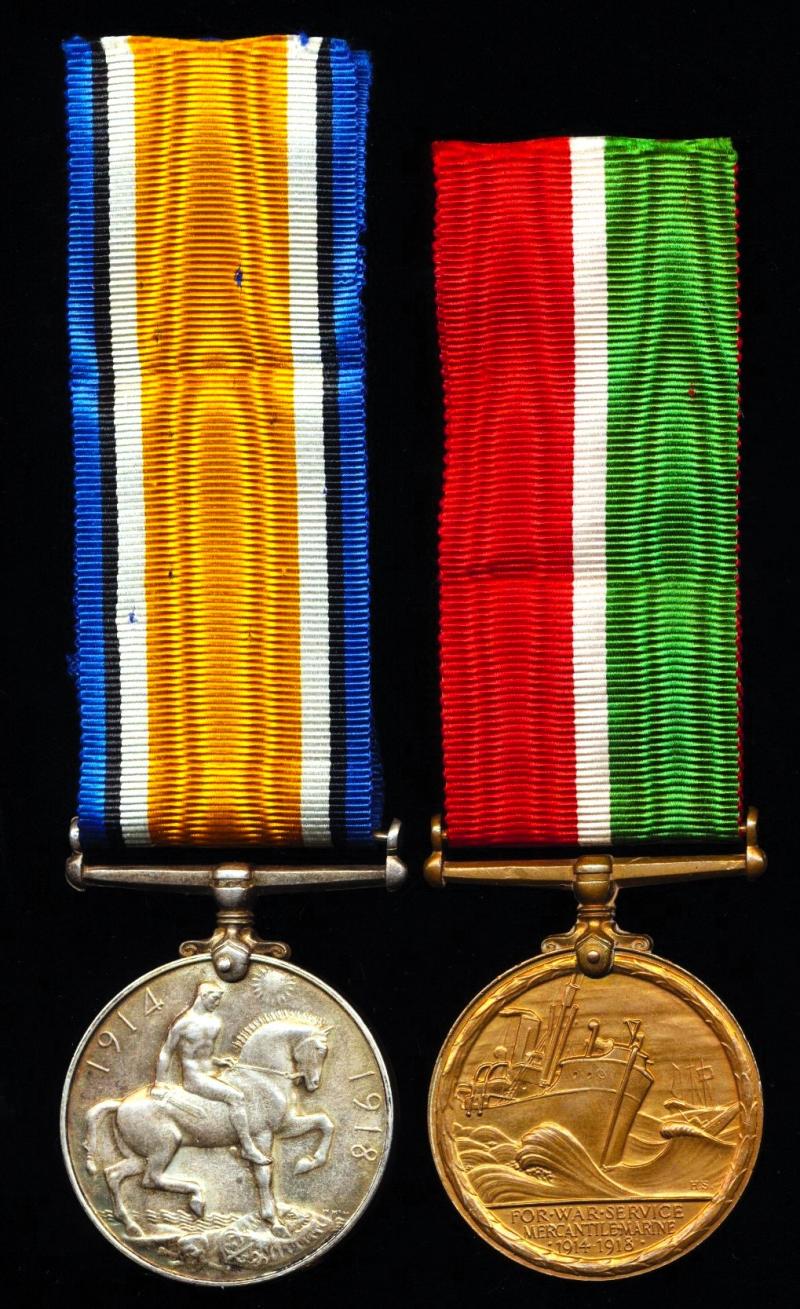A Scottish seaman's 'Killed by enemy U-Boat Action' Great War casualty medal pair: 'Donkeyman' James Alexander Dunlop, late S.S. 'Hogarth'
- British War Medal. Silver issue (James A. Dunlop)
- Interallied Victory Medal (James A. Dunlop)
Killed-in-Action: James Alexander Dunlop lost his life to enemy action, when the U-Boat 107 torpedoed and sank the S.S. Hogarth, of the Aberdeen Steam Navigation Company on, 7 June 1918, when only 1 x crew-member survived the sinking, the ship sinking with the loss of 26 x dead
The life and supreme sacrifice of Jamesd Alexander Dunlop is commemorated in perpetuity by the Commonwealth War Graves Commission, where his name is included on one of the panels of the Tower Hill Memorial, London
Important: James A. Dunlop is a unique name in the Mercantile Marine medal index cards held at The National Archives
Medals verification: Both medals verified as entitled per the recipients unique medal index card held and accessible at The National Archives, in the file series BT 351/1/39133
S.S. Hogarth: Was a merchantman built for carrying passengers and cargo between Aberdeen & London, constructed by Hall Russell & Co. Ltd at Aberdeen in, 1893. On 7th June 1918, 'Hogarth' was torpedoed and sunk by the German submarine 'UB 107' off the Longstone Light, Farne Islands whilst on passage from London to Aberdeen with a general cargo. Only a single survivor was picked up after floundering for nearly two days on a life-raft. The rest of the ship's crew were less fortunate, with the loss of the remaining 26 crew, including James Alexander Dunlop, and the Master D. Stephen, being killed in the attack and subsequent sinking of the S.S. 'Hogarth'
See the Aberdeen Maritime Museum collections which contain a wealth of materials and artefacts related to the S.S. Hogarth, including the war medals. memorial plaque and memorial scroll awarded in respect of the ships master Captain D. Stephen. Amongst the museum's collection is a group photograph of the crew of S.S. Hogarth - presumably including James A. Dunlop
James Alexander Dunlop, eldest son of James Alexander Dunlop (Chemical Worker Foreman) and Christina Falconer Dunlop (nee McDonald) was a native of, Aberdeen, Scotland, where he was born in 1887. By the time of the 1901 National Census for Scotland, James was living with his parents and 6 x younger siblings, comprising, 4 x brothers (John, Charles William & David) and 2 x sisters (Mary & Margaret ), at their residence located at, 15 Baltic Street, Aberdeen, and at which time he was, as a 14 year old employed as a 'Boilermaker's Apprentice'. England, the family had relocated to, Walton, West Darby, Lancashire,a district of the great port city of Liverpool, from where the father continued to ply his trade as a 'Mariner'. In 1891, the family occupants comprised the parents, 4 x sons, vis Allan, Duncan, Charles & Duncan, together with a daughter, Margaret. In 1911, Duncan (described as a Joiner), was living with his widowed mother, his elder brother Allan, and a niece, Grace Campbell, at their residence at, By In 1891, the family comprising the parents, and children, were residing at, 36 Esmond Street, Anfield, Liverpool. At the time of his death, James Alexander Dunlop had been residing with his wife, Jessie Ann Dunlop (nee Davidson) and family at, 25 Justice Street, Aberdeen, Scotland
Condition: Both medals fitted with original silk watered 'moire' ribands
Condition: EF
Code: 23441






